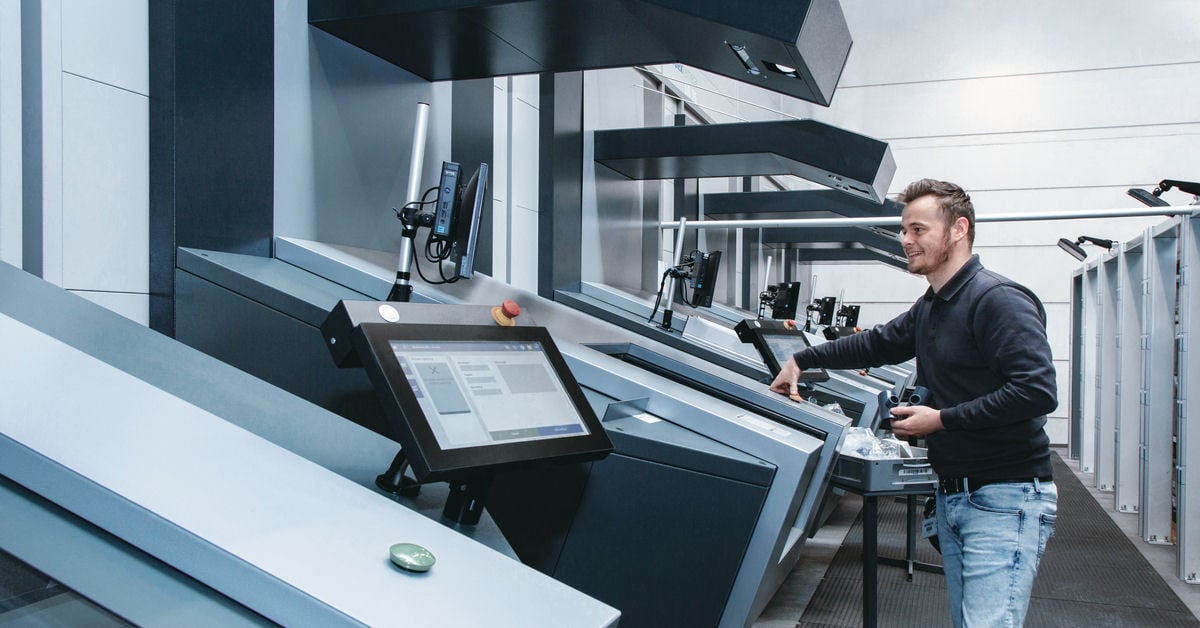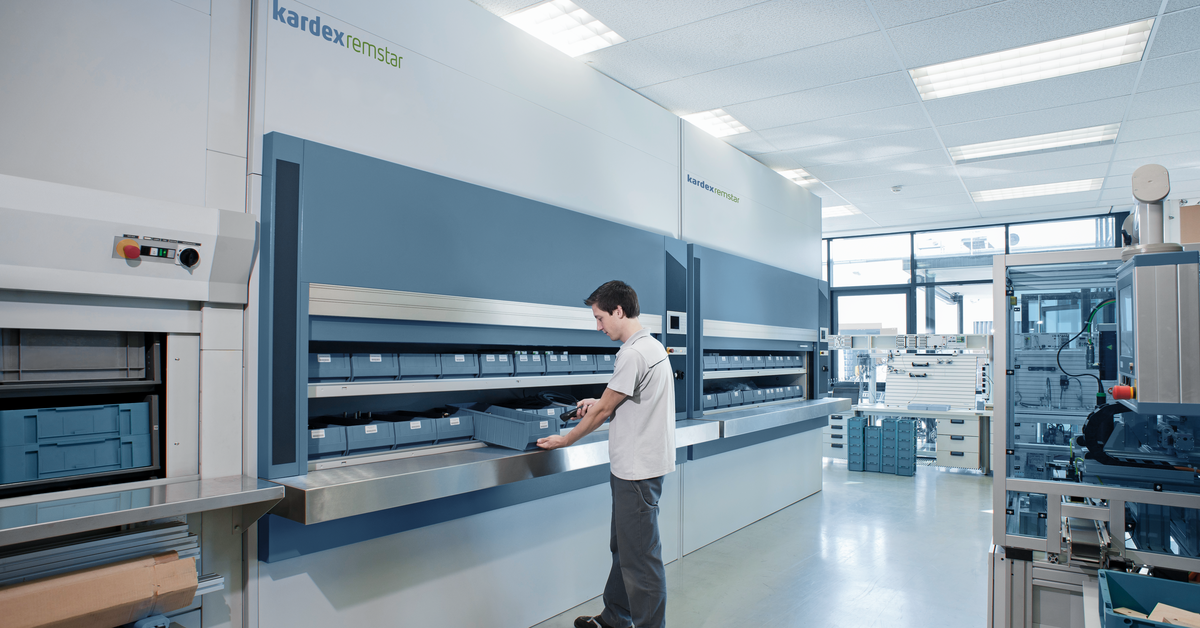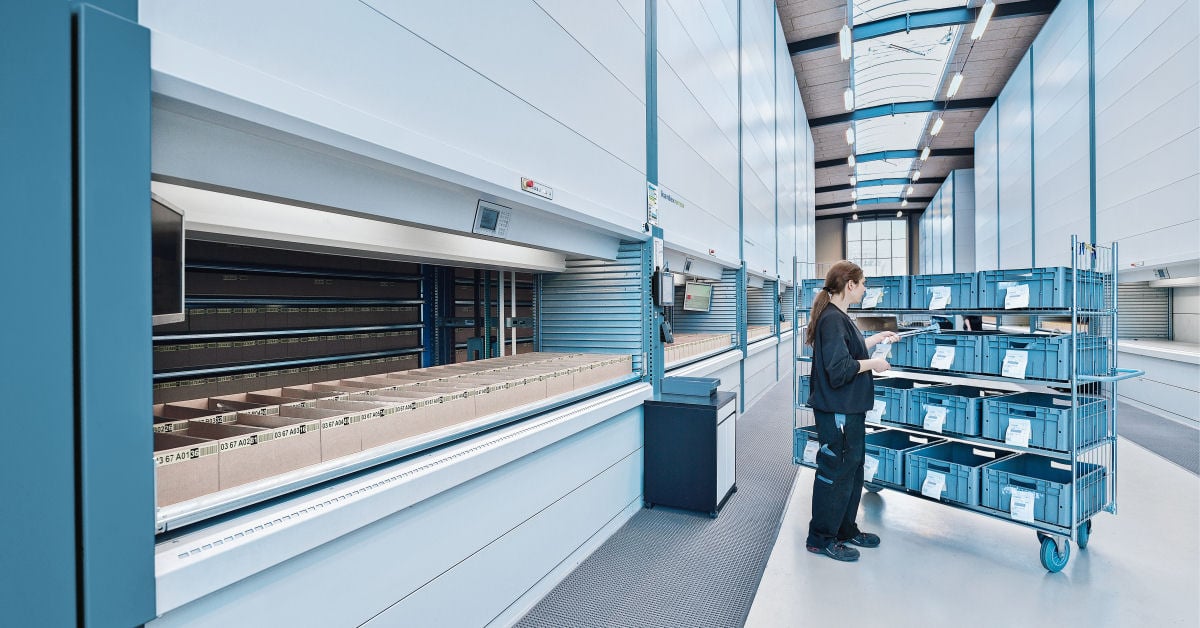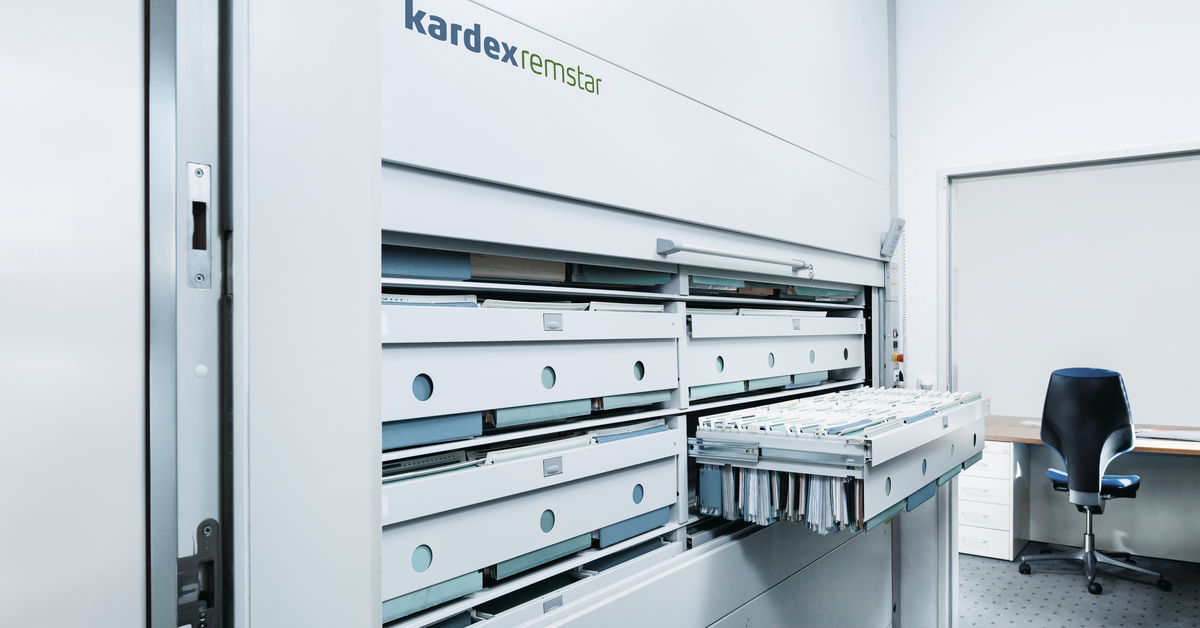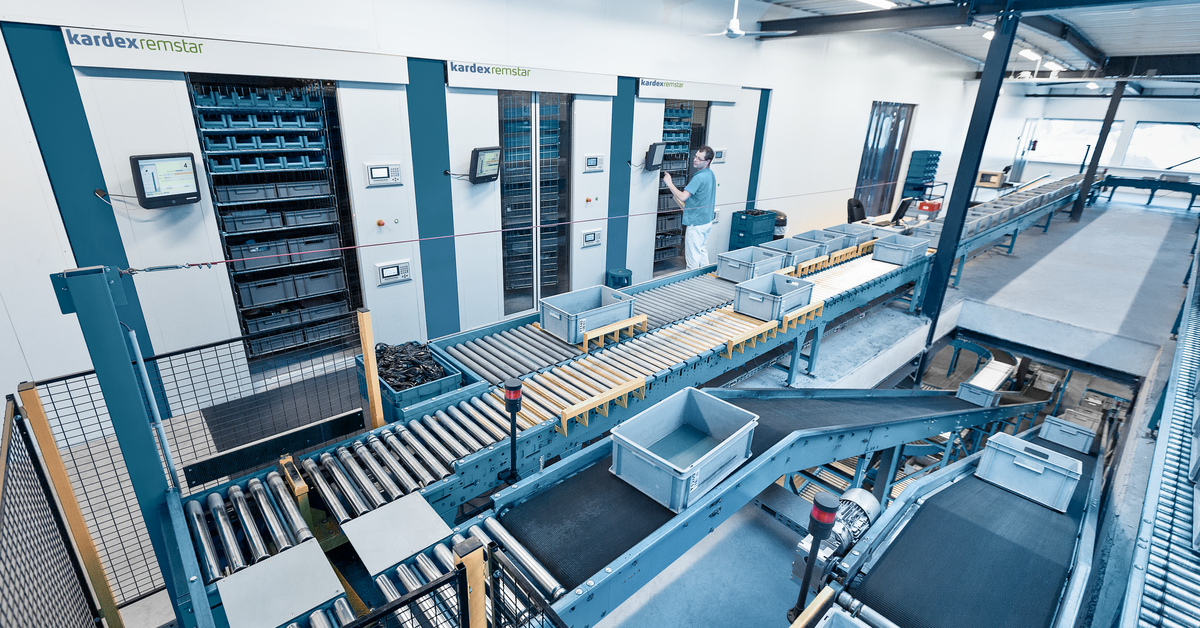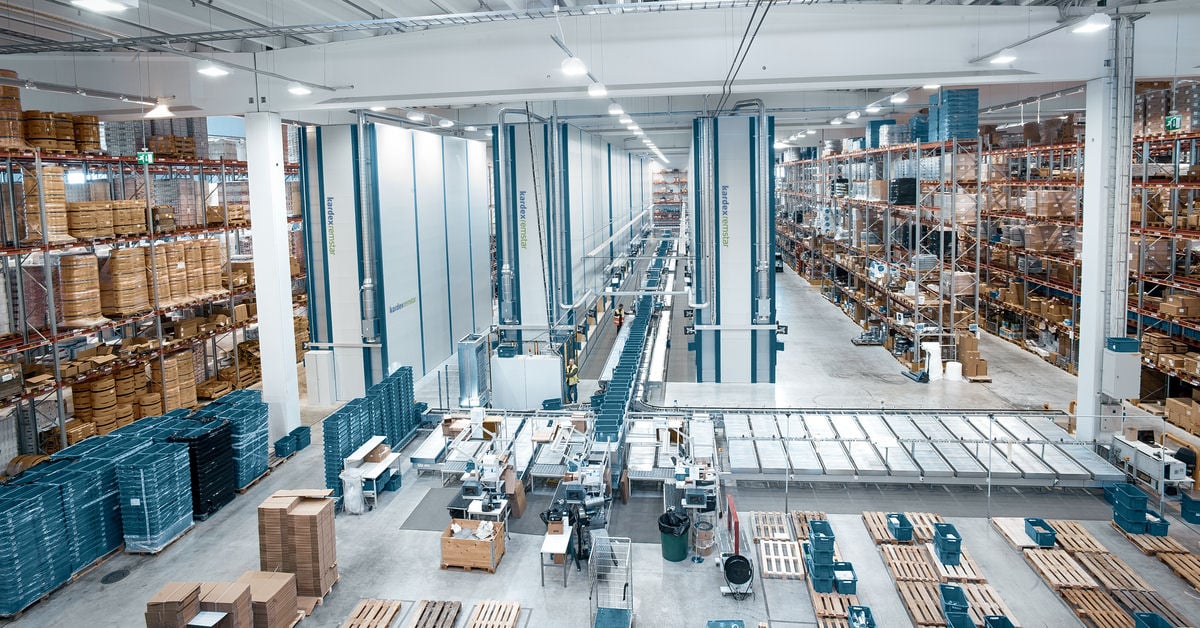
ASRS 101: Automated Storage and Retrieval Systems
Author: Christina Dube
Publish Date: July 15, 2024
Automated Storage and Retrieval Systems (also referred to as ASRS systems) are most commonly used in manufacturing and distribution facilities. They typically replace large areas of shelving to save floor space, improve safety and increase productivity. With varying technologies and applications, it can be a bit overwhelming researching ASRS systems for the first time. Have no fear. We've put together a one-stop "Intro to Automated Storage and Retrieval Systems" for you complete with definition, technology differences, primary benefits, common applications and signs it's time to start considering ASRS. Class is in session!
What is ASRS? Automated Storage and Retrieval System Defined
Automated Storage and Retrieval Systems are just that – automated systems that efficiently and securely store items in a compact footprint. They also allow users to easily and quickly retrieve items when needed. Several companies manufacture a wide variety of self-contained, goods-to-person, automated storage and retrieval systems (ASRS). The technologies handle different volumes, types and velocities of non-palletized inventory at variable speeds to accommodate varying throughput demands. When considering the options, keep in mind both the storage density your facility needs as well as your throughput goals.
Automated Storage and Retrieval Systems also have a laundry list of alternative names such as dynamic storage systems, high density storage and retrieval systems and goods-to-person picking technology.
“ASRS solutions have been the backbone of efficient warehouse operations worldwide for decades. With over 140,000 Kardex Remstar installations globally, any modern warehouse that hasn’t embraced automation is falling behind.”
Cal Bowers
Senior Director of New Business - North America
Kardex Remstar

Manual vs Automated Picking
Automated Storage and Retrieval System Technologies
The ASRS technologies on the market handle different volumes, types and velocities of non-palletized inventory at variable speeds to accommodate varying throughput demands.
Automated storage can be broken down into 7 major technologies:
Vertical Carousel Modules (VCMs)
A series of carriers traveling bi-directionally in a vertical loop around a track, vertical carousels deliver stored items safely and quickly to an ergonomically positioned work counter at the operator’s command.
Horizontal Carousel Modules (HCMs)
Highly dense storage bins mounted on an oval track which rotates horizontally to deliver product storage locations to an operator, for quick order fulfillment.
Vertical Lift Modules (VLMs)
These enclosed automated storage and retrieval systems consist of two columns of trays with an inserter/extractor in the center delivering trays of stored items to an operator as needed.
Crane Based Mini Load AS/RS
With a single, crane-mounted load handling device dedicated to each extremely dense storage aisle, mini-loads handle loads in cases, totes or trays.
Vertical Buffer Modules (VBMs)
A cost effective, tote handling system consisting of an enclosed shelving system with a movable mast in the center. It stores and retrieves totes, delivering them to an ergonomic picking station or automatically delivering them via an outbound conveyor.
Robotic Cube Storage
In a Robotic Cube Storage System, all inventory is placed into bins and stacked inside a cube. Smart robots work at the top of the cube to shuffle, sort and retrieve bins and deliver them to a workstation (port) as needed. This type of goods-to-person automated storage system can deliver increasingly higher throughput based on the number of independently moving robotic shuttles inducted into the system.
Floor Robots (AGVs/AMRs)
AGVs & AMRs store inventory on portable storage shelving that is retrieved and transported from storage to an operator access area by a fleet of autonomous, mobile robots.
FOR A DEEPER DIVE: 8 Major ASRS Technologies
TECHNOLOGY COMPARISONS: Vertical Lift Modules vs Vertical Carousel Modules | Vertical Carousel Modules vs Horizontal Carousel Modules | New vs Used ASRS
"One of the things that sets VLMs apart is their ability to fit into warehouse layouts without major modifications other ASRS solutions require. This flexibility not only minimizes downtime during installation but also accelerates the time to value, enabling warehouses to start benefiting from the technology much faster."
Doug Card
Director of Systems Sales - North America
Kardex Remstar

10 Signs it's Time for ASRS Systems
- Replenishment Overload – If workers are spending just as much time replenishing as they are picking you’re wasting time – consider automation!
- Extensive Travel Time – If workers are wasting time traveling several miles during a shift to access inventory – consider automation!
- Excessive Search Time – If, upon arrival at a picking destination, workers must spend time visually search for the correct item and match up part numbers – consider automation!
- Rising Picking Errors – If picking errors are on the rise, wasting money and risking your company reputation – consider automation!
- Struggling Throughput – If you’re struggling to keep up with order cut-off time, or hiring seasonal workers to keep up with demand – consider automation!
- Damaged Items – If valuable inventory is often found damaged and unusable – consider automation!
- Misplaced Inventory – If inventory is frequently misplaced or temporarily lost – consider automation!
- Pilfered Product – If inventory is often unexplainably missing – consider automation!
- Facility at Max Capacity – If you’re building is bursting at the seams and there’s no room for growth – consider automation!
- Risk of Operator Injury – If workers are at risk of injury – consider automation!
INFOGRAPHIC DOWNLOAD: 10 Reasons to Automate Your Intralogistics
Benefits of Automated Storage and Retrieval Systems
There are many benefits of Automated Storage and Retrieval Systems – they include:
- Compact Footprint – ASRS technologies provide highly dense storage and can save up to 85% of floor space occupied by shelving. Calculate the True Cost of Storage Space
- Reduced Labor Requirements – ASRS systems require 2/3 less labor to operate when compared to manual shelving. Calculate the True Cost of Labor
- Improved Pick Accuracy – automated ASRS uses pick to light technology to direct the operator to the exact location of the stored item, achieving 99.9% pick accuracy rates. Calculate the True Cost of Accuracy
- Greater Inventory Control – ASRS solutions manage inventory so you always know what you have and more importantly - where it is. 6 Ways to Increase Inventory Control
- Improved Safety & Ergonomics – ASRS technologies create a safe and ergonomic working environment for employees. Position Your Order Picking Team for Success
FOR A DEEPER DIVE: 6 Major Benefits of Automated Storage and Retrieval Systems
YOU MAY ALSO LIKE: Common Misconceptions about ASRS
"Folks reach out to me worried about running out of space, but when they see how ASRS can tackle their labor issues too, it's a real game changer."
David Brown
Area Sales Manager - Houston, TX
Kardex Remstar

Common ASRS Systems Applications
These automated storage systems are used to manage small parts inventories, sub-assembly, work-in-process, maintenance and repair parts and large tools and dies in a variety of applications found within manufacturing and distribution facilities. Common applications include:
- Storage: Providing high density storage parts and components used in a manufacturing process
- Order picking: Offering compact, fast and reliable access to items required for distribution, bringing stored items to the operator for fast order fulfillment, supported by software integration
- Kitting: Managing the process of receiving inventory, group (kitting) component parts for assembly and storing kits until required
- Order Consolidation: Providing a compact solution to temporarily hold incomplete orders awaiting additional items before shipment
- Buffering: Offering a highly dense storage solution for inventory or process buffering
- Assembly: Storing work-in-process or sub-assemblies for later use
- Tools, Dies & Molds: Ergonomic and secure handling of heavy and often expensive tooling required in an automated production process
- Maintenance & Repair Parts: Providing compact storage of maintenance parts onsite to reduce downtime
- Replenishment & Returns: Managing inventory for replenishment and returns processes
- Climate Controlled and Clean Room Environments: Provides cold, clean and dry management of storage
ASRS Solutions by Industry
From manufacturing and distribution to hospital supply rooms, government and administration, organizations can benefit from automated storage and retrieval systems (ASRS) in several areas throughout their facility. Whether your application requires a simple storage solution or a more complex system, there are different types of automated equipment to meet your needs. Implementing goods to person, dynamic storage and retrieval systems at your facility can save floor space, increase productivity, improve picking accuracy, increase inventory control and improve worker ergonomics.
Industries benefiting the most from ASRS include:
ASRS Costs and ROI
The cost of an automated storage and retrieval system (ASRS) includes the cost of the equipment/technology, accompanying software, controls, delivery & installation, and implementation of the solution into your production system. Ongoing costs include updated training and regularly scheduled maintenance. Dynamic automated storage solutions often provide an ROI of under 18 months due to the labor, space and picking efficiencies they provide. To learn more about these cost factors or to cost justify your particular project, check out the links below.
FOR MORE: Calculating the Cost of ASRS: 5 Contributing Factors
"With ASRS, the initial cost is offset by reduced labor costs, optimized space utilization, and improved picking speed. These combined efficiencies provide a compelling ROI within a short period of time, making ASRS a smart financial decision for modern warehouses."
Brian Baker
Regional Business Director - North America
Kardex Remstar

Glossary of ASRS Related Terms
Automated Storage and Retrieval Systems (ASRS): ASRS refers to a computer controlled system for automatically storing and retrieving goods from defined storage locations.
Automation: The technique of using an automatic system to manage processes to reduce human interaction.
Bins, Totes, Containers, Cartons, Case: A vessel for storing goods/parts/items. Learn More
Bulk Storage: The process of storing materials and packages in larger quantities. Bulk storage generally keeps goods in their original packaging.
Case Picking: Filling orders with full packaged cases for shipment. Commonly stored in pallet locations.
Cube: The amount of space occupied by an item in an automated storage and retrieval system, measured in cubic feet.
Ergonomics: Establishing work spaces and conditions to reduce physical exertion for employees. Automated storage and retrieval systems deliver items to a worker at an ergonomic work height within the golden zone, the area between the waist and shoulders to reduce bending and reaching for items. Learn More
Fixed Aisle: Fixed Aisle (F/A) Storage & Retrieval Systems consist of one or more long, narrow aisles framed on both sides by a steel storage rack structure. Within this structure loads are automatically stored and retrieved under computer control. The storage/retrieval function in each aisle can be performed a variety of ways. However, the most common way is by a machine that consists of a floor running, traveling structural frame or vertical mast that guides and supports a hoisting carriage on which loads are carried. One or more shuttles or insertion/extraction devices on the hosted carriage manipulates loads into and out of adjacent or opposing storage rack positions. All three machine motions; horizontal (down aisle), vertical and shuttle action are independently and automatically controlled.
Floor Robots: This solution stores inventory on portable storage shelving that is retrieved and transported from storage to an operator access area by a fleet of autonomous, mobile robots. After the operator selects the required item or items from the shelf, the robot returns it to storage. Ideal for slow to medium velocity inventory, throughput ranges from 100 to 300 lines per hour. Throughput can also be expanded easily with the addition of more robots. The standard weight capacity of 1,000 pounds per shelving system can be increased with the heavy duty model handling up to 3,000 pounds per shelving unit.
Goods to Person: The act of delivering items directly to a person via an automated storage and retrieval system as opposed to the person walking to retrieve goods. This method reduces walk and search time for the employee.
Horizontal Carousel Module (HCM): Consist of highly dense storage bins mounted on an oval track which rotates horizontally to deliver slow- to medium-moving product storage locations to an operator. These automated storage and retrieval systems handle both items and cases weighing up to 200 pounds. To generate maximum picking speed and throughput, they are often installed in groups, known as pods. Quick Facts PDF
Intralogistics: The material logistics and material handling plus information management within the four walls/boundaries of a manufacturing or distribution center.
Inventory Management Software: A software application designed to work in coordination with automated storage and retrieval systems. It manages the inventory within the system, tracking storage location, quantity, part dimensions, etc.
Material Handling: Material Handling is the movement, storage, control and protection of materials, goods and products throughout the process of manufacturing, distribution, consumption and disposal. The focus is on the methods, mechanical equipment, systems and related controls used to achieve these functions. See also, Supply Chain, Supply Chain Management, Logistics and Third Party Logistics. Note that all of referenced terms are highly interrelated and their definitions are frequently intermingled.
Mini Load AS/RS: A type of automatic storage and retrieval system that handles loads that are typically contained in small containers or totes. Typical load weights fall in the 100 to 500 lb. range, and occasionally as much as 750 to 1000 lbs.
Mobile Shelving: A shelving system mounted on floor tracks. These shelves can be densely packed together when not in use for space savings. If a shelf is needed, it can be quickly accessible by either an automated control or manual hand crank.
Modular Drawer Cabinet: Modular drawer cabinets are an efficient storage option for small or high value parts/items. Drawers can be partitioned to optimize space to provide higher density.
Pick to Light: A light directed technology used to reduce paper pick lists and increase pick accuracy. Learn More
Paternoster: Another term for vertical carousel. This type of vertical conveyor is common in Europe. See vertical carousel.
Robotic Cube Storage: All inventory is placed into bins and stacked inside a cube. Smart robots work at the top of the cube to shuffle, sort and retrieve bins and deliver them to a workstation (port) as needed. Learn More
Robotic Shuttles: This dynamic storage solution uses robotic shuttles to travel independently from level to level, riding on narrow rails at each storage level. They retrieve stored items at high speeds, with throughput ranging from 200 to 700 lines per hour. Handling cases, totes or trays weighing from 35 to 65 pounds, this type of goods-to-person, automated storage system can deliver increasingly higher throughput based on the number of robotic shuttles inducted into the system.
Split Case Order Picking: A process used to fill orders by picking quantities less than a case. This requires items be removed from a full case and picked into a smaller container for shipping or delivery.
Static Storage System: A storage system where there is no mechanical movement, also called manual storage system.
Storage: The process of holding items in a specific location for order picking, buffering or holding for shipment.
Storage Racks: A storage system with single or multiple levels that is used for stacking individual items or pallet loads.
Vertical Carousel Module (VCM): Comprised of a series of carriers attached to a chain drive, a motor powers the carriers’ bi-directional travel in a vertical loop around a track—similar to a Ferris wheel. These automated storage and retrieval systems deliver slow- to medium-velocity items safely and quickly to an ergonomically positioned work counter at the operator’s command. Quick Facts PDF
Vertical Lift Module (VLM): The most flexible technology in this category, the vertical lift module is engineered to automatically adjust when your inventory changes. With trays capable of handling up to 2,200 pounds, these enclosed dynamic storage solutions consist of two columns of trays with an inserter/extractor in the center. The inserter/extractor automatically locates and retrieves stored trays of slow- to medium- velocity items from both columns and presents them to the operator at a waist-high pick window at rates from 125 to 475 items per hour. Quick Facts PDF
Vertical Buffer Module (VBM): The vertical buffer module is an enclosed shelving system with a movable mast running down a center aisle for picking and storage of totes. This bin handling system, is designed to be able to work ahead of the operator and queue up the next pick for maximum throughput of the system. Totes can be delivered to an ergonomic turntable picking station or can be automatically handled via inbound and outbound conveyor. Multiple units can be connected via conveyor and totes can be delivered to remote picking stations. The system is designed to be modular, scalable and highly energy efficient. Quick Facts PDF
Warehouse Management System (WMS): Software used to support and optimize a warehouse’s day to day operations - from inventory acceptance, to storage, to picking, packing and shipping.
ASRS Photo Gallery
Author Bio
Christina Dube
Marketing Director - Americas
Kardex Remstar
Bringing over two decades of material handling experience with her, Christina Dube is a recognized authority in material handling. She has a solid understanding of warehouse processes and inventory management practices – and more importantly how to improve these areas through the implementation of automated storage and retrieval solutions. Her blog posts offer actionable strategies and valuable perspectives based on her real-world experience, providing her audience with the tools and knowledge needed to elevate their warehouse processes and inventory management practices by integrating advanced automated picking solutions.



-1.png?width=200&name=WarehouseInsights_US_ASRS-101-Comprehensive-Guide%20(border)-1.png)
